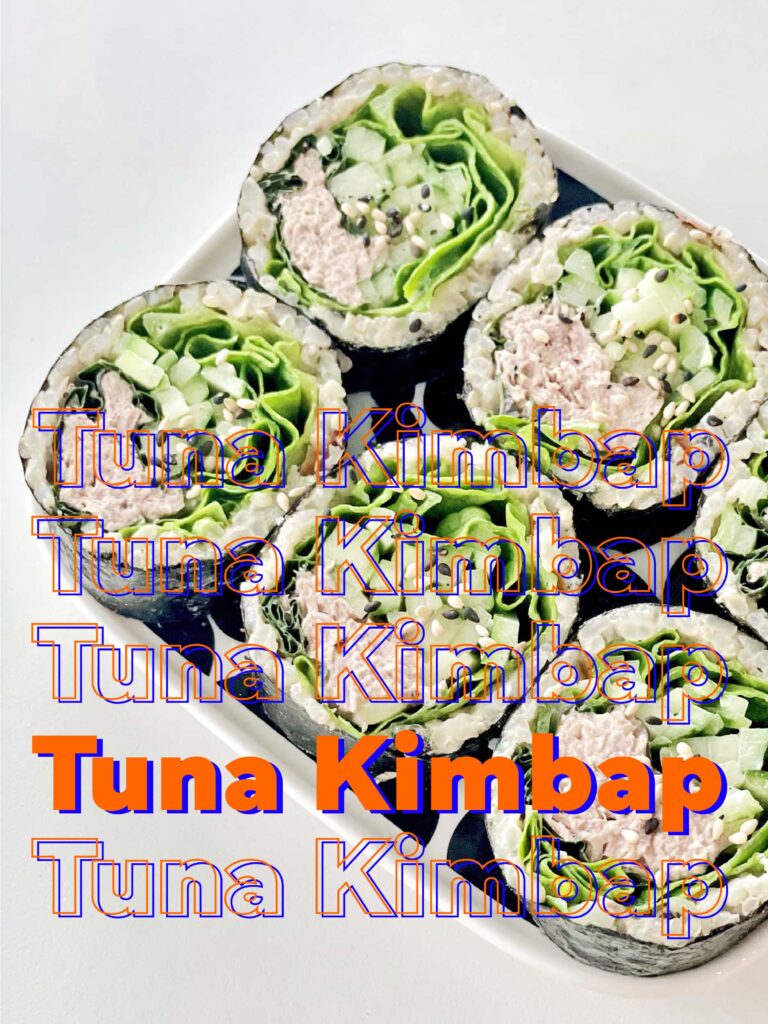A balanced combination of soft and crunchy elements. Fresh and combination of savory, salty, and slightly sweet flavors
Kimbap aka, gimbap is a Korean dish made with a sheet of dried seaweed. ‘Gim’ or ‘Kim’ means seaweed and ‘Bap’ means rice literally a seaweed rice roll. It can rolled with many different condiments: vegetables, meat, fish, and more with cooked rice.
It is a perfect to-go and must-have menu at school picnics in Korea.
Basically, it is so versatile; that you can wrap it with any ingredients that you prefer.
The most common classic ingredients for the kimbap are pickled radish, egg, carrot, spinach, ham, fishcake, and braised burdock root.
This time, changed the ingredients that I had 🙂 I love to eat Kimbap anytime for a simple and quick meal.
You can easily buy at the convenience store in Korea.
Tuna kimbap is a popular Korean dish made with seasoned rice rolled in seaweed sheets and filled with various ingredients, including tuna. The taste of tuna kimbap is savory and slightly sweet due to the seasoning of the rice, which usually includes furikake, sesame oil, and sesame seeds. The tuna adds a rich and slightly fishy flavor, but it is not overpowering.
In terms of texture, tuna kimbap has a balanced combination of soft and crunchy elements. The rice is moist and sticky, providing a soft and chewy texture. The seaweed adds a crisp and slightly chewy bite. Inside the roll, the tuna filling adds a creamy and smooth texture, while other fillings like vegetables can provide crunchiness.
Overall, tuna kimbap offers a delightful combination of flavors and textures, making it a popular and satisfying dish.










Easy Tuna Kimbap Recipe: Fresh and Healthy
Description
Kimbap aka, gimbap is a Korean dish made with a sheet of dried seaweed. ‘Gim’ or ‘Kim’ means seaweed and ‘Bap’ means rice literally a seaweed rice roll. It can rolled with many different condiments: vegetables, meat, fish, and more with cooked rice.
It is a perfect to-go and must-have menu at school picnics in Korea.
Basically, it is so versatile; that you can wrap it with any ingredients that you prefer.
The most common classic ingredients for the kimbap are pickled radish, egg, carrot, spinach, ham, fishcake, and braised burdock root.
This time, changed the ingredients that I had :)
I love to eat Kimbap anytime for a simple and quick meal.
You can easily buy at the convenience store in Korea.
Tuna kimbap is a popular Korean dish made with seasoned rice rolled in seaweed sheets and filled with various ingredients, including tuna. The taste of tuna kimbap is savory and slightly sweet due to the seasoning of the rice, which usually includes furikake, sesame oil, and sesame seeds. The tuna adds a rich and slightly fishy flavor, but it is not overpowering.
In terms of texture, tuna kimbap has a balanced combination of soft and crunchy elements. The rice is moist and sticky, providing a soft and chewy texture. The seaweed adds a crisp and slightly chewy bite. Inside the roll, the tuna filling adds a creamy and smooth texture, while other fillings like vegetables can provide crunchiness.
Overall, tuna kimbap offers a delightful combination of flavors and textures, making it a popular and satisfying dish.
Ingredients
Rice seasoning
Tuna seasoning
Dipping sauce
Instructions
-
In a bowl, mix the drained tuna, mayonnaise, and black pepper. Set aside.
-
In another bowl, mix the rice, sesame oil, furikake, and sesame seeds.
-
Place a sheet of seaweed on a bamboo sushi mat or a clean surface.
-
Spread a thin layer of cooked sticky rice evenly onto the seaweed, leaving about 1 inch of space at the top.
-
Place the lettuce leaf, cucumber, perilla leaves, and tuna mixture in the middle of the rice.
-
Start rolling the seaweed tightly until you reach the top edge. Press gently to secure the roll.
-
Using a sharp knife, slice the rolls into bite-sized pieces.
-
Serve the tuna kimbap with dipping sauce.


